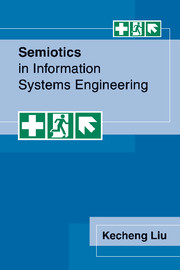Book contents
- Frontmatter
- Contents
- Preface
- 1 Introduction
- Part one Semiotic framework and methods
- Part two Applications
- 9 From semiotic analysis to systems design
- 10 Semantic temporal databases
- 11 Normbase: a new approach to information management
- 12 Case study: development of a land resources information system
- 13 Case study: development of a test construction system
- Appendix A Semantic templates and surrogate specification
- Appendix B LEGOL applications in the CRIS case
- Bibliography
- Index
10 - Semantic temporal databases
Published online by Cambridge University Press: 19 September 2009
- Frontmatter
- Contents
- Preface
- 1 Introduction
- Part one Semiotic framework and methods
- Part two Applications
- 9 From semiotic analysis to systems design
- 10 Semantic temporal databases
- 11 Normbase: a new approach to information management
- 12 Case study: development of a land resources information system
- 13 Case study: development of a test construction system
- Appendix A Semantic templates and surrogate specification
- Appendix B LEGOL applications in the CRIS case
- Bibliography
- Index
Summary
The method of Semantic Analysis offers a means of representing information requirements and database modelling. Based on the database theory and semiotic methods, a semantic temporal database is proposed. The semantic temporal database provides a technology of management of the data with semantic and temporal properties. A semantic temporal database language, LEGOL, has been developed for the specification of norms. LEGOL statements can specify constraints and triggers, and can be executed by a LEGOL interpreter.
Databases
A database, from the information technology point of view, can be regarded as a kind of electronic filing cabinet (Date 1995, p. 2). It can be defined as a persistent collection of logically related data that allows shared access by many users. A DBMS (Data Base Management System) is the application-independent software that protects and manages databases. Since the late 1960s when the pioneering DBMS, IMS, was published, the database technology has provided ever improving tools for information management. Since then, the development of new types of DBMS and research into new ways of organising information have been taking place. This section provides a quick review of some major contemporary types of database systems and of the presentation of the semantic temporal databases which are considered highly relevant to business information management purposes.
Developments in databases management systems
Relational DBMS is the most widespread and popularly used type of database systems nowadays. Other types of systems are also being introduced to meet diversified application purposes, typically the objected-oriented databases and deductive databases.
- Type
- Chapter
- Information
- Semiotics in Information Systems Engineering , pp. 133 - 149Publisher: Cambridge University PressPrint publication year: 2000



